Alabama’s Dirty Little Secret
November 19, 2020



 Fishing,Hunting,SCA Articles
Fishing,Hunting,SCA Articles
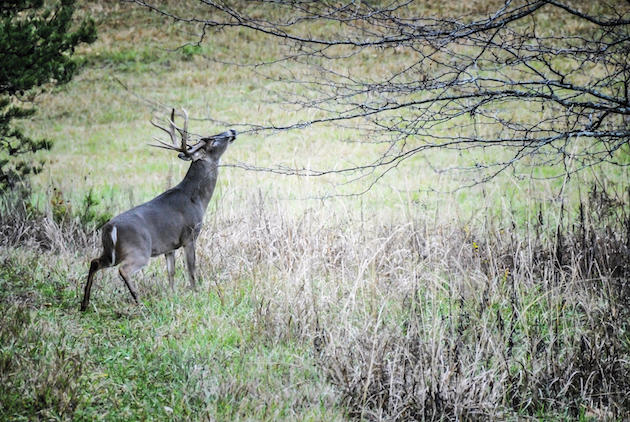
It’s in the soil beneath your feet. Rich, black earth that produces nice bucks, nice bass, and really nice folks.
Stretching from Mississippi to Georgia, Alabama’s Black Belt covers much of the southern portion of the state. So named because of its dark, rich soil, the region is ripe with possibilities for outdoorsmen. The bass fishing, for instance, is first rate year-round. And the excellent white-tailed deer hunting runs from October into early February.
A perfect spot for a late-season deer hunt is Water Valley. The name alone suggests that visitors should plan to kick back, take a chill pill, and just go with the flow. Here you’ll find comfortable lodging, great cooking, and Southern hospitality poured on thick and sweet as molasses over home-cooked biscuits. The experience is as soothing as the clear creek that trickles nearby. And if that’s not enough to keep you sassy-fied, there’s always the great hunting.
I discovered Water Valley in 2013 while desperately trying to find a way to extend my deer hunting beyond Jan. 1. I live in South Carolina, where the season closes New Year’s Day. Knowing that hunting in parts of Alabama runs to Feb. 10, I called Pam Swanner with the Alabama Black Belt Adventures Association. With her help, I scheduled a trip for January 2014, and after the new year, headed to the western border of the state. My hunt yielded a nice buck and many fond memories. It also proved to be habit-forming.

In Alabama’s Black Belt, the whitetail rut continues well into January. (Photo via Thinkstock)
So in early February I showed up once again on the doorstep at Water Valley. This time I was accompanied by my long-time friend Jack Stewart, a farmer from Timmonsville, South Carolina.
After an eight-hour drive from South Carolina to the western side of Alabama, we arrived at the lodge just in time for dinner. A couple other guests, Kendall from Louisiana and Rick from Florida, sat by the huge fireplace in the dining room, along with a skittish pack of Yorkies stirring at their feet. Meanwhile, owners Jake and Pia Utsey were in the kitchen preparing spaghetti and salads while their son, John Jacob, and daughter, Gaddy, set the table and poured sweet tea. (Down here, there is no other kind of tea.)
Jack and I introduced ourselves and pulled a couple of rockers closer to the glowing flames. A moment later, the door opened and a linebacker-size fellow entered with an armload of split hickory for the fire. He introduced himself as Nathan, who guides and works for Water Valley during the late winter but spends most of the fall guiding for bear, elk, and caribou in Alaska. In the summer, he makes a decent income gathering deer and elk antlers near his home in Montana and selling them to restaurant chains, furniture makers, and the like.
The Utseys have several experienced guides on staff, and following a morning breakfast, the guides carry hunters to and from their stands and help with tracking and dressing out the animals. After the morning hunt, the family whips up a big spread for lunch that may include homemade gumbo and build-your-own sandwiches. The afternoon hunt is topped off with an awesomely satisfying Southern feast. Homemade dessert, too. The Utseys have the routine down pretty good and basically leave their guests with only one task: shoot straight.
Curious about the extended deer season in their part of Alabama, I asked, “Where do your clients come from?”
“All over the country,” Pia said. “Florida, New York, California, Pennsylvania — and many of them are long-time repeat customers.”
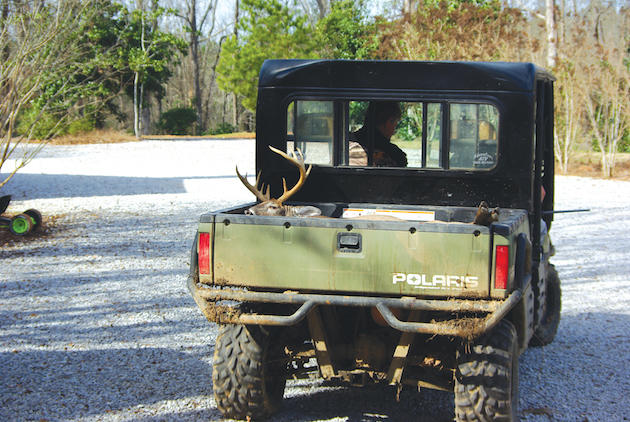
A guide takes a buck to the lodge.
She said they even have guests from Japan and Romania.
There are a lot of really good reasons to come here most any time of year. Water Valley Lodge has more than 30,000 acres available for deer hunting, which begins Oct. 15. The place is also lousy with hogs, which make a great quarry from February until it’s just too hot to mess with them. Spring turkey hunts are also available.
“What most people seem to enjoy about Water Valley is the hospitality,” Pia says. “They come here year after year because we are literally inviting them into our home. For a lot of them, the hunting is secondary. We live here. We feel like they’re coming to visit us, so we make them feel as if they’re part of our family.”
Water Valley is steeped in history, having been a working farm for seven generations. The Utseys still live in the two-story farmhouse at the entrance to the property, while guest quarters include completely refurbished tenant houses.
“We felt we had an obligation to preserve the old tenant houses that were on the property,” explains Pia. “So we had them moved here near the main house where they’ve been carefully upgraded.”
Along with comfortable accommodations, the food is out of this world. While each day starts with a continental breakfast, lunch and dinner are home-cooked feasts prepared by the whole family.
Just sitting by the fire chatting with the Utseys is a treat in itself. Jake tells of working for a congressman in the political mud wallow of Washington before deciding to come home to Alabama to earn a respectable living. “I wanted to get dirty and do honest work,” he says.
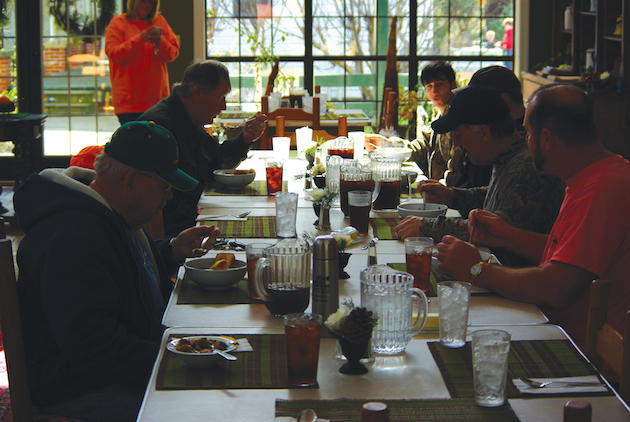
Hunters enjoy their evening meal.
“My children are the seventh generation to live here. Our ancestors came here in the mid-19th century and homesteaded this area. We still live on a portion of the original property. Part of it we lost after the Civil War.”
He says the post-war Utseys would hide near the railroad tracks and swipe cotton bales from northbound trains. “Stealing from the Northerners was considered okay,” he says with a sly smile.
After returning to the farm, Jake rebuilt many of the structures on the property and set about creating a first-rate hunting operation. According to Jake, the main ingredients — ample acreage, good habitat, and plenty of game — were already in place. Jake estimates that the property has 40 to 50 deer per square mile, which is a very high density. Add to that an unusually late rut and a good buck-to-doe ratio, and the superb lodging becomes just the icing on the cake.
“You can be from Virginia or New Jersey or Minnesota or wherever, but you can start the new year off in Alabama for a January rut hunt. That’s always been one of our big selling points,” Jake says.
Along with the happy hunting grounds and Southern hospitality, there is also a great deal of professionalism and order to the hunting experience. Each hunter has a closet in the boot room for clothes, guns, gear, and, of course, muddy boots.
When I wasn’t eating or thinking about eating, I was hunting. Jack and I saw a lot of deer during our stay, but warm weather had shut down much of the daytime rutting activity. We were both allowed one doe along with a buck, but of course we were holding out for the antlered variety. Hard to pull the trigger on a nervous doe that keeps looking over her shoulder. You’re convinced there’s a monster ten-pointer in the brush ready to throw caution to the wind in the name of love. At least, that’s the way it works on the hunting channels.
On our final morning the temperatures had dropped into the mid-40s (still toasty by most standards but a far cry from the 80-degree temperatures of the previous day), and everyone saw deer, but the big bucks continued to hunker down. An hour after sunrise I was cozy in a ground blind when a doe walked up close enough to spit on, if I had been so inclined. Moments later a buck appeared at the end of the food plot some 100 yards away.
He was in a bit of a hurry, so I hastily threw up the rifle and scoped his antlers. Nothing to write home about, but an older deer and the horns were legal. And did I mention it was the last day for venison? After the shot the deer ran into the swamp, leaving a good blood trail that coursed through some of the nastiest briars and brambles I’ve ever climbed through.
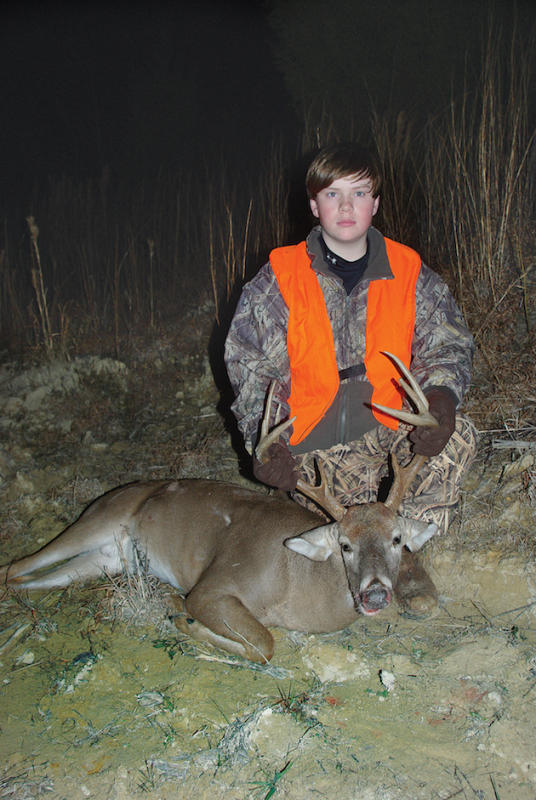
Young John Jacob Utsey killed this ten-point buck as it headed to a food plot.
I found him piled up in a creek, vultures already circling overhead in the rising thermals of the warming late morning. Not a wall-hanger, but a mature buck. I was happy to have taken my second buck at Water Valley in two visits.
John Jacob Utsey was even more fortunate later that evening, taking a beautiful ten-pointer at the crack of dusk. The buck stepped out into a food plot, sniffing the air for a couple of does that had just departed the field. That’s what the rut is all about. Maybe next year.
Months later, as spring came to a close, I returned to Alabama to chase largemouth bass. Situated on the southeastern edge of the Black Belt is a “bass pond” of legend. Forming part of the Alabama-Georgia line, 46,000-acre Lake Eufaula is famous for producing high-quality largemouth bass in large quantities. Part of the Chattahoochee River system, Lake Eufaula, also known as Walter F. George Lake, was created in the 1950s by the U.S. Army Corps of Engineers.
In June my wife, Kathy, and I had the opportunity to take to the water with Tracy Beall, one of the long-time authorities on the lake. He’s fished these waters since he was a boy and knows where to go to find the bite year-round.
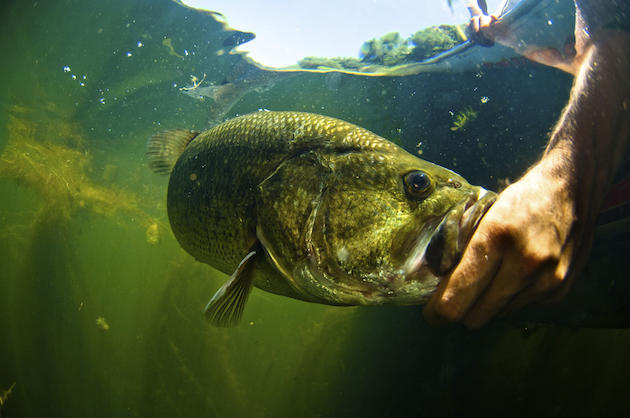
Lake Eufaula holds an abundance of largemouth, hybrid, and spotted bass. (Photo via Thinkstock)
“You just have to stay on ’em,” he says. “One of the keys to catching bass here is the water generation from the dam. That movement of water pulls the plankton up from the bottom, which turns on the shad, which turn on the predator fish like hybrids, spotted bass, and largemouth. Knowing that schedule is the key to success on Eufaula.”
Tracy has the latest in Humminbird technology, including a GPS system which he had used to mark spots where he’d caught fish earlier in the week. Of course, even with modern fish-locating equipment and perfect timing of the water generation, bass are by nature fussy. That pickiness, combined with a humongous thunderstorm that sent us rushing for the nearest boathouse, made for a slow first afternoon.
The next morning proved much better. Tracy picked us up at the state park dock at a very civilized 9 a.m. After some searching we were able to enjoy several hours of solid action. Along with some good-sized largemouths, we landed some hybrids and feisty spotted bass. We fished mostly with plastic worms, though jigs and spoons were productive in certain spots.
Tracy has caught a lot of big bass on the lake, including a couple of lunkers that weighed more than ten pounds. These days, however, he stays busy guiding other anglers. Along with largemouth, Tracy is planning to fish more for crappie and catfish.
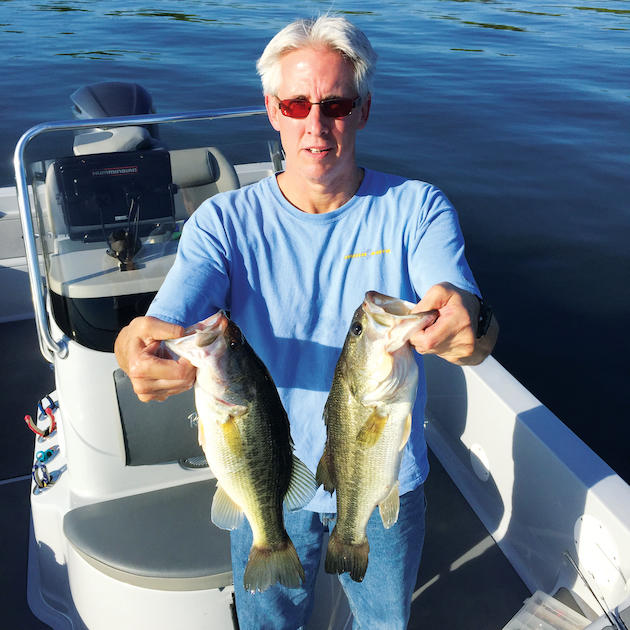
Craig Packard of Humminbird holds a pair of four-pound largemouth bass from Lake Eufaula.
“They have some really big catfish here,” he says with a nod. “I mean, huge.”
Kathy and I stayed at Lakepoint Resort State Park, which is located on Lake Eufaula. Along with cabins and camping, there’s also a hotel and restaurant right on the water’s edge. If you plan to bring a boat, there’s docking and launching on site.
